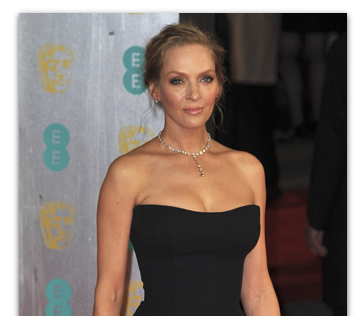Uma Thurman has long embodied a special fusion of strength, elegance, and artistic versatility, drawing attention with her statuesque height. She is significantly taller than many of her male co-stars and even her ex-husband Ethan Hawke, standing at 5 feet 11¼. Instead of limiting her to typecast roles, this physical characteristic became a crucial component of her dominant on-screen persona. Her choice of shoes frequently draws attention to her imposing figure, with heels from high-end labels like Christian Louboutin, Manolo Blahnik, and Jimmy Choo highlighting her already impressive height.
Thurman redefined what it meant to be memorable on screen by entering Quentin Tarantino’s world as Mia Wallace in Pulp Fiction. Her long frame contributed to the rhythm of scenes that have since become iconic in addition to providing visual drama. Her height subtly rebalanced the power dynamics when she was paired opposite David Carradine or John Travolta in Kill Bill, enhancing her character’s authority in a remarkably natural and effective way. Thurman owned tall; she wasn’t just playing tall.
| Full Name | Uma Karuna Thurman |
|---|---|
| Date of Birth | April 29, 1970 |
| Age | 55 |
| Height | 5′ 11¼″ (181 cm) |
| Birthplace | Boston, Massachusetts, USA |
| Occupation | Actress, Model |
| Years Active | 1985–present |
| Spouses | Gary Oldman (1990–1992), Ethan Hawke (1998–2005) |
| Partner(s) | Arpad Busson (2007–2009, 2010–2014) |
| Children | 3 (including Maya and Levon Hawke) |
| Parents | Robert Thurman, Nena von Schlebrügge |
| Source | Wikipedia – Uma Thurman |
Instead of hiding her height, she has always embraced it at fashion shows and premieres. She tends to wear long coats and fitted silhouettes that accentuate her body size. She has been a juror and president of the “Un Certain Regard” jury at the Cannes Film Festival, where she has regularly wore elegant yet structured ensembles that produce a very distinct and deliberately elegant silhouette. She makes use of her height rather than trying to appear shorter or exaggerated.
It’s important to remember that Thurman’s height is a component of her cultural image and not just a number. Uma’s height has generated conversations about gender dynamics in casting and the continued underrepresentation of tall women in romantic lead roles, much like Tom Cruise’s height has frequently generated tabloid attention. But whether it was in Batman & Robin, where she dominated scenes as Poison Ivy, or in Gattaca, where she starred opposite Ethan Hawke, she has consistently subverted this narrative.
According to fashion critics, Uma’s larger shoe size—US 11—makes her even more relatable in a field that tends to glamorize extremes. She has been pictured wearing custom shoes that are made to support her body while still looking elegant on red carpets and at brand events. The functional difficulties taller actresses may encounter are highlighted by this reality, which is surprisingly little discussed. Uma has, however, handled it with a very effective flair, never sacrificing comfort for style.
In addition to having her mother’s long limbs and statuesque appearance, her daughter Maya Hawke, who is currently a rising star due to Stranger Things and her budding music career, also has her mother’s facial features. It’s evident that Uma’s height has subtly become a part of an inherited creative legacy as viewers and critics compare the two more frequently. Maya is also a tall woman, both professionally and physically.
Thurman’s career trajectory is a striking example of the film industry’s growing acceptance of a wider range of body types. She has recently dabbled in television, landing parts in shows like Chambers, Smash, and Super Pumped, where her presence was equally commanding despite the medium’s change. She expands into smaller screens rather than contracting on them.
From Nymphomaniac to Henry & June, Thurman has employed her physicality as a means of achieving narrative power rather than as a means of intimidation. She has been cast by directors not only because of her skill or beauty but also because of her ability to command attention. Characters traversing morally challenging terrain benefit greatly from this dominance, which is frequently visually represented through height.
Uma Thurman showed that height can be an actor’s ally by working frequently with auteurs such as Tarantino and Lars von Trier. This is especially true when height is combined with emotional nuance and intellectual depth. Her performances are introspective, multi-layered, and frequently uncomfortable in their rawness; they are never merely visual. She redefined what glamour could look like, so it’s not because of convention that her image is still glamorous.
Thurman’s refusal to stoop, either literally or figuratively, has proven remarkably effective in a film industry that has historically demanded that women appear demure. She was always perceived as attractive, maternal, intelligent, and dangerous despite her height. As an alternative, it broadened the range of roles that she and subsequent tall actresses could play.




